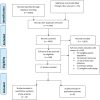Prevalence of chronic non-communicable diseases in Ethiopia: A systematic review and meta-analysis of evidence
- PMID: 35991039
- PMCID: PMC9385028
- DOI: 10.3389/fpubh.2022.936482
Prevalence of chronic non-communicable diseases in Ethiopia: A systematic review and meta-analysis of evidence
Abstract
Background: Non-communicable diseases (NCDs) are a growing global health challenge disproportionately impacting low- and middle-income settings, including Ethiopia. Currently, the body of evidence describing the burden of NCDs is fragmented, inconsistent, health facility- or institution-based, and out-dated in Ethiopia. We conducted a systematic review of the literature and meta-analysis of the prevalence of NCDs in community settings in Ethiopia.
Review methodology: Community-based quantitative studies published in English between January 1st, 2012, and June 30th, 2022, that reported on the prevalence of NCDs in Ethiopia were included. A systematic search of Medline, Embase, Scopus, CINAHL, and Global Health using pretested search terms related to NCDs was conducted, and data were extracted using a piloted data extraction proforma adapted from the Joanna Briggs Institute tool. Meta-analysis was performed using Stata 16. While the pooled prevalence of Diabetes Mellitus (DM) and undiagnosed (DM) was computed and presented using forest plots, then overall prevalence of NCDs and other various types of NCDs were narratively synthesized. I 2 was used to assess heterogeneity. Studies that did not fulfill the criteria (used similar tool to measure the types of NCDs) for meta-analysis were narratively synthesized.
Results: Twenty-two studies met the inclusion criteria. Five studies measured the prevalence of NCDs (all NCDs together), ranging from 29 to 35% (prevalence estimates not pooled). The pooled prevalence of Diabetes Mellitus (DM) across ten studies was 5% (95% CI: 4-7%). Three studies each reported on the prevalence of undiagnosed DM (pooled prevalence 5%, 95% CI: 4-7%) and pre-DM (pooled prevalence 7%, 95% CI: 3-14%%). In a narrative analysis the prevalence of cardiovascular conditions ranged from 13.4 to 32.2% (n = 3 studies), cancer mortality ranged from 4 to 18% (n = 3 studies) and respiratory conditions ranged from 1 to 18% (n = 3 studies). Some studies have determined more than one NCDs and that is why the total number of studies are exceeding more than twenty studies.
Conclusion and recommendations: Our analysis found that approximately one-third of Ethiopians have an NCD, with cardiovascular diseases the most common of all NCDs. The prevalence of respiratory conditions also appears high, but there are insufficient data for a pooled estimate. Whilst the prevalence of DM appears relatively low, there is evidence that the magnitude is increasing. Public health actions to address the high burden of cardiovascular and respiratory diseases, as well as the increasing magnitude of DM in Ethiopia, must be prioritized.
Systematic review registration: PROSPERO [CRD42020196815].
Keywords: Ethiopia; NCD; cardiovascular diseases; non-communicable diseases; systematic review.
Copyright © 2022 Tesfay, Zorbas, Alston, Backholer, Bowe and Bennett.
Conflict of interest statement
The authors declare that the research was conducted in the absence of any commercial or financial relationships that could be construed as a potential conflict of interest.
Figures
References
-
- World Health Organization . Noncommunicable Diseases Country Profiles 2018, Geneva: (2018).
-
- World Health Organization . World Health Statistics 2019: Monitoring Health for the SDGs, Sustainable Development Goals, Geneva: (2019).
-
- WHO. Noncommunicable Diseases. (2018). Available from: https://www.who.int/news-room/fact-sheets/detail/noncommunicable-diseases (accessed July 12, 2020).
Publication types
MeSH terms
LinkOut - more resources
Full Text Sources
Medical
Miscellaneous




